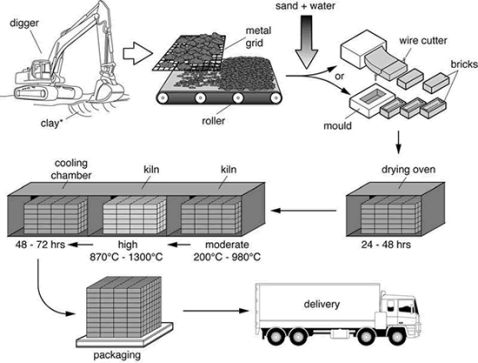雅思流程图范文《砖块的制作》(含9分范文及考官点评)
雅思流程图范文《砖块的制作》(含9分范文及考官点评) WRITING TASK 1
You should spend about 20 minutes on this task.
The diagram below shows the process by which bricks are manufactured for the building industry.
Summarise the information by selecting and reporting the main features, and make comparisons where relevant.
Write at least 150 words.
Brick manufacturing

* Clay: type of sticky earth that is used for making bricks, pots, etc.
【满分范文】
The process by which bricks are manufactured for the building industry can be
outlined in seven consecutive steps. First the raw material, clay, which was just below the surface of soil in certain clay-rich areas has to be dug up by a digger.
Then the lumps of clay are placed on a metal grid in order to break up the big chunks of clay into much smaller areas, which fall through the metal grid onto a roller, whose motion further segregates the bits of clay. Sand and water are added to make a
homogenous mixture, which is then either formed in moulds or cut into brick-shaped
pieces by means of a wire cutter.
Those fresh bricks are then kept in a drying oven for at least 24 and a maximum of 48 hours, several dozens if not hundreds of bricks at a time. The dried bricks are then transferred to a so-called kiln, another type of high temperature oven. First they are kept at a moderate temperature of 200 ℃ -1300 ℃ . This process is followed by cooling down the finished bricks for 48 to 72 hours in a cooling chamber.
Once the bricks have cooled down and have become hard, they get packaged and delivered to their final destination, be it a building site or storage.
(215 words)
【考官评语】
Band 9
This response fully satisfies the requirements of the task. All key features of each stage of the process are appropriately and accurately presented. An excellent overview is given at the beginning of the response and this skilfully incorporates part of the rubric, changing the grammatical function, to give a brief summary of the whole process. The message is very easy to read, with seamless cohesion that attracts no attention. Paragraphing, linking and referencing are all skilfully managed. The language used is very fluent and sophisticated. A wide range of vocabulary and structures are used with full flexibility and accuracy. Only rare minor ‘slips’ can be found and these do not detract from the high rating.
第二篇:雅思大作文:考官眼中的9分范文
雅思大作文:考官眼中的9分范文
我惊喜的发现我教了十年雅思,居然碰到了难得一见的9分文章,我给了几位前任的IELTS Examiner打了分数,都给出了9分。我们来欣赏一下:
Globalization is a declaration of war upon all other cultures. And in culture wars, there is no exemption of civilians, there are no innocent bystanders. Why should it be expected that ancient and rooted civilizations are going to accept this peripheralisation without a struggle? The answer to that is that globalization carries an implicit promise that it will relieve poverty and offer security—perhaps the most ancient of human dreams. Because of the power of global capitalism to create wealth, it is assumed that this priority must sweep aside all other human preoccupations, including all existing institutions, interpretations and searches for meaning in the world.
It is disingenuous to assume that economy, society and culture operate in separate spheres. This suggests that, one, exposed to the globalizing imperative, no aspect of social life, customary practice, traditional behaviour will remain the same.
There have been, broadly, two principal responses in the world, which we may call the fatalistic and the resistant. It is significant that among the most fatalistic have been the leaders of G-7, Ex-President Clinton said globalization is a fact not a policy choice Tony Blair said it is inevitable and irreversible. It may be considered paradoxical that the leaders of the most dynamic and expanding economies in the world offer such a passive, unchallenging view of what are, after all, human-made arrangements. These are among the richest and most proactive regimes, which can wage endless war on the great abstraction, that is terror, topple regimes and lay down one WTO law for the poor and another for themselves. Is their helplessness in the presence of these mighty economic and cultural powers?
There are two aspects to resistance. One is the reassertion of local identities—even if local actually means spread over very large parts of the world. The reclaiming of the local is often focused in the field of culture—music, songs and dance. This suggests an attempt to guarantee it from the effects of economic integration; a kind of cordon sanitaria set up around a dwindling culture. Some people believe it is possible to get the best of both world—they accept the economic advantages of globalization and seek to maintain something of great value—language, tradition and custom. This is the relatively response. The other has become only too familiar: the violent reaction, the hatred of both economic and cultural globalization which may not merely perceive, but feel in the very core of their cognition, as an inseparable violation of identity. The resentment of many Muslims toward the U.S and Israel, the defensive posturing of Vindu fundamentalism, opposed both to Islam and Christianity, are the most vivid dramatizations of this.
-
雅思流程图的写作(含范文深度点评)
WRITINGTASK1Youshouldspendabout20minutesonthistaskTheillustrationsbelowshow…
-
雅思写作流程图的模板以及范文
海量资料下载免费学习英语wenkuhtm申请网址雅思写作流程图的模板以及范文雅思流程图范文之砖块的制作Theprocessbywh…
-
雅思小作文范文--装置图 流程图 表格
小作文流程图Thegivengraphindicatestheproceduresofglassbottlerecyclebyth…
-
雅思小作文之流程图范文
Youshouldspendabout20minutesonthistaskThediagrambelowshowsthemethodofobtain…
-
雅思小作文写作流程图
流程图1这张图表展示出一个电冰箱是如何工作的2根据这个图表在第一阶段高压液体流进细管道冰箱中的食物放出蒸汽3在这一阶段高压液体被蒸…
-
雅思流程图的写作(含范文深度点评)
TheillustrationsbelowshowhowchocolateisproducedSummarisetheinformaitonbysel…
-
雅思流程图范文
TheillustrationsbelowshowhowchocolateisproducedSummarisetheinformaitonbysel…
-
怎么写 雅思流程图
流程图流程图6点参考要领1找到流程图的过程起点终点2找到图上标出的已知动作如果出现生词尽量猜测无词用自己的语言3按照步骤分段描述千…
-
雅思流程图的写作
TheillustrationsbelowshowhowchocolateisproducedSummarisetheinformaitonbysel…
-
雅思流程图 地图题 资料
流程图流程图6点参考要领1找到流程图的过程起点终点2找到图上标出的已知动作如果出现生词尽量猜测无词用自己的语言3按照步骤分段描述千…